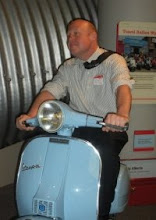 N 322.56
N 322.56This plate with its cornflower blue foliage and fake pagodas was clearly an attempt to imitate the early ceramics from China. It is heavy and not translucent. It has some marks that real china would not have and their was a bit of staining around the interior which real china would also resist.
It is earth ware and has the under glazing of these types of plates. There is a potters or ceramics mark on the back



This oddly shaped stoneware vase looks to be thrown on a wheel with the very dark brown found in some of the stove ware. It has a very curious shape with an almost enclosed top with an indentation that has a small hole with a second hole on the side. The highly glossy glaze suggests a tin glaze. It isn't a sanitary ware or certainly wouldn't be practical as such so I am chalking it up to a curious vase. There are no potters mark on this item so I am wondering if it might be made by a local potter for local use in the mid 19Th century? It seems to be produced with a measure of skill but I am unclear on its function



N43.57
This is an stoneware jug with a salt glaze. It has no formal kind of markings but on the bottom we cab see John ? Esq. Has thrown and formed this jug in 1867. It has an interesting dual spout that would let the air in for easy pouring and drinking. The handle must have been attached with the slip but the color is so consistent . I wonder if John was inclined to enjoy a pull from the jug and wanted one that didn't back fire on him when he drew it to his lips, or did he just want an easy pour solution for his wife?

N22.68
Lusterware sounds like a modern miracle but it goes way back to the Egyptians. There are many types with an iridescent finish achieved by adding metallic oxides into an overlaid glaze finish. This sweet teapot looks all the world like silver at first until you get the lid open and you see a deep brown slip. There is no tarnishing on this item so I am thinking that this could be mercury as well.
They really threw mercury into everything in the 19Th century century. I am surprised there weren't shinny mercury baby bottles. It does seem to demonstrate how that century wasn't one of simple brown grey blue wool and understated old timely colors. They liked their flashy space age looking stuff as well. The moniker Lusterware smacks of 50's space age so interesting to see that a similar sensibility for the shiny was present in a century that was also seeing so much innovation and change. I do wonder if this was embraced by lower middle class who could not afford silver. It seems a good substitute.




No comments:
Post a Comment